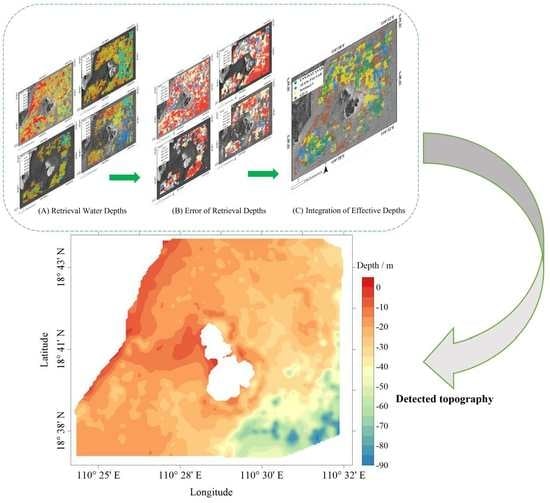Shallow Sea Topography Detection from Multi-Source SAR Satellites: A Case Study of Dazhou Island in China
Abstract
1. Introduction
2. Methods
2.1. The Linear Wave Theory
2.2. Wave Retrieval by FFT
3. Study Area and Data
3.1. Dazhou Island
3.2. SAR Data
3.3. Reference Water Depth
4. Experiment of Underwater Topography Detection Based on MSSTD
4.1. Estimation of Wave Period
4.2. Wave Retrieval
4.3. Calculation of Water Depth
- (1)
- Mean Absolute Error (MAE)
- (2)
- Mean Relative Error (MRE)
- (3)
- Correlation Coefficient (R)
4.4. Filtering of Valid Water Depth
5. Results
5.1. Topography from MSSTD
5.2. Comparison between Detected Topography and the Chart Depth
6. Discussions
6.1. Influence of Satellite Parameters on Bathymetry
6.2. Influence of FFT on Bathymetry
6.3. Sensitivity Analysis of MSSTD to Different Water Depth
6.4. Limitation of MSSTD
7. Conclusions
Author Contributions
Funding
Data Availability Statement
Acknowledgments
Conflicts of Interest
References
- Bell, P.S. Shallow Water Bathymetry Derived from an Analysis of X-Band Marine Radar Images of Waves. Coast. Eng. 1999, 37, 513–527. [Google Scholar] [CrossRef]
- Leu, L.-G.; Kuo, Y.-Y.; Liu, C.-T. Coastal bathymetry from the wave spectrum of spot images. Coast. Eng. J. 1999, 41, 21–41. [Google Scholar] [CrossRef]
- Cao, B.; Deng, R.; Zhu, S.; Liu, Y.; Liang, Y.; Xiong, L. Bathymetric Retrieval Selectively Using Multiangular High-Spatial-Resolution Satellite Imagery. IEEE J. Sel. Top. Appl. Earth Obs. Remote Sens. 2021, 14, 1060–1074. [Google Scholar] [CrossRef]
- Huang, L.; Yang, J.; Meng, J.; Zhang, J. Underwater Topography Detection and Analysis of the Qilianyu Islands in the South China Sea Based on GF-3 SAR Images. Remote Sens. 2020, 13, 76. [Google Scholar] [CrossRef]
- Fan, C.; Wang, X.; Zhang, X.; Gao, D. A Newly Developed Ocean Significant Wave Height Retrieval Method from Envisat ASAR Wave Mode Imagery. Acta Oceanol. Sin. 2019, 38, 120–127. [Google Scholar] [CrossRef]
- Li, H.; Stopa, J.E.; Mouche, A.; Zhang, B.; He, Y.; Chapron, B. Assessment of Ocean Wave Spectrum Using Global Envisat/ASAR Data and Hindcast Simulation. Remote Sens. Environ. 2021, 264, 112614. [Google Scholar] [CrossRef]
- Wang, H.; Yang, J.; Lin, M.; Li, W.; Zhu, J.; Ren, L.; Cui, L. Quad-Polarimetric SAR Sea State Retrieval Algorithm from Chinese Gaofen-3 Wave Mode Imagettes via Deep Learning. Remote Sens. Environ. 2022, 273, 112969. [Google Scholar] [CrossRef]
- Wang, H.; Wang, J.; Yang, J.; Ren, L.; Zhu, J.; Yuan, X.; Xie, C. Empirical Algorithm for Significant Wave Height Retrieval from Wave Mode Data Provided by the Chinese Satellite Gaofen-3. Remote Sens. 2018, 10, 363. [Google Scholar] [CrossRef]
- Bian, X.; Shao, Y.; Zhang, C.; Xie, C.; Tian, W. The Feasibility of Assessing Swell-Based Bathymetry Using SAR Imagery from Orbiting Satellites. ISPRS J. Photogramm. Remote Sens. 2020, 168, 124–130. [Google Scholar] [CrossRef]
- Pereira, P.; Baptista, P.; Cunha, T.; Silva, P.A.; Romão, S.; Lafon, V. Estimation of the Nearshore Bathymetry from High Temporal Resolution Sentinel-1A C-Band SAR Data—A Case Study. Remote Sens. Environ. 2019, 223, 166–178. [Google Scholar] [CrossRef]
- Santos, D.; Abreu, T.; Silva, P.A.; Baptista, P. Estimation of Coastal Bathymetry Using Wavelets. JMSE 2020, 8, 772. [Google Scholar] [CrossRef]
- Brusch, S.; Held, P.; Lehner, S.; Rosenthal, W.; Pleskachevsky, A. Underwater Bottom Topography in Coastal Areas from TerraSAR-X Data. Int. J. Remote Sens. 2011, 32, 4527–4543. [Google Scholar] [CrossRef]
- Fan, K.; Huang, W.; He, M.; Fu, B.; Zhang, B.; Chen, X. Depth Inversion in Coastal Water Based on SAR Image of Waves. Chin. J. Ocean. Limnol. 2008, 26, 434–439. [Google Scholar] [CrossRef]
- Roeber, V.; Ranchin, T.; Dubranna, J.; Cloarec, M. Extraction of Bathymetric Features Using Multiple SAR Images Produced by Sentinel-1. In Proceedings of the Sixth International Conference on Remote Sensing and Geoinformation of the Environment (RSCy2018); Themistocleous, K., Hadjimitsis, D.G., Michaelides, S., Ambrosia, V., Papadavid, G., Eds.; SPIE: Paphos, Cyprus, 2018; p. 22. [Google Scholar]
- Bian, X.; Shao, Y.; Tian, W.; Wang, S.; Zhang, C.; Wang, X.; Zhang, Z. Underwater Topography Detection in Coastal Areas Using Fully Polarimetric SAR Data. Remote Sens. 2017, 9, 560. [Google Scholar] [CrossRef]
- Huang, L.; Fan, C.; Meng, J.; Yang, J.; Zhang, J. Shallow Sea Topography Detection Using Fully Polarimetric Gaofen-3 SAR Data Based on Swell Patterns. Acta Oceanol. Sin. 2022, 41, 13. [Google Scholar]
- Bian, X.; Shao, Y.; Tian, W.; Zhang, C. Estimation of Shallow Water Depth Using HJ-1C S-Band SAR Data. J. Navig. 2016, 69, 113–126. [Google Scholar] [CrossRef]
- Mishra, M.K.; Ganguly, D.; Chauhan, P. Ajai Estimation of Coastal Bathymetry Using RISAT-1 C-Band Microwave SAR Data. IEEE Geosci. Remote Sens. Lett. 2014, 11, 671–675. [Google Scholar] [CrossRef]
- LeBlond, P.H.; Mysak, L.A. Waves in the Ocean; Elsevier: Amsterdam, The Netherlands, 1981. [Google Scholar]
- Howd, P. Beach Processes and Sedimentation; Wiley: Hoboken, NJ, USA, 1998. [Google Scholar]
- Bruck, M.; Lehner, S. Coastal Wave Field Extraction Using TerraSAR-X Data. J. Appl. Remote Sens 2013, 7, 073694. [Google Scholar] [CrossRef]
- Collard, F.; Ardhuin, F.; Chapron, B. Extraction of Coastal Ocean Wave Fields From SAR Images. IEEE J. Ocean. Eng. 2005, 30, 526–533. [Google Scholar] [CrossRef]
- Li, X.; Lehner, S.; Rosenthal, W. Investigation of Ocean Surface Wave Refraction Using TerraSAR-X Data. IEEE Trans. Geosci. Remote Sens. 2010, 48, 830–840. [Google Scholar] [CrossRef]
- Arko, R.; Ryan, W.; Carbotte, S.; Melkonian, A.; Coplan, J.; O’Hara, S.; Chayes, D.; Weissel, R.; Goodwillie, A.; Ferrini, V.; et al. The Global Multi-Resolution Topography (GMRT) Synthesis. In Proceedings of the AGU Fall Meeting Abstracts, San Francisco, CA, USA, 10–14 December 2007; Volume 2007, p. IN51B-0405. [Google Scholar]
- Boccia, V.; Renga, A.; Rufino, G.; D’Errico, M.; Moccia, A.; Aragno, C.; Zoffoli, S. Linear Dispersion Relation and Depth Sensitivity to Swell Parameters: Application to Synthetic Aperture Radar Imaging and Bathymetry. Sci. World J. 2015, 2015, 374579. [Google Scholar] [CrossRef] [PubMed]
- Misra, A.; Ramakrishnan, B.; Muslim, A.M. Synergistic Utilization of Optical and Microwave Satellite Data for Coastal Bathymetry Estimation. Geocarto Int. 2022, 37, 2323–2345. [Google Scholar] [CrossRef]
- Wiehle, S.; Pleskachevsky, A. Bathymetry Derived from Sentinel-1 Synthetic Aperture Radar Data. In Proceedings of the EUSAR 2018, 12th European Conference on Synthetic Aperture Radar, Aachen, Germany, 4–7 June 2018; VDE: Frankfurt am Main, Germany, 2018; pp. 1–4. [Google Scholar]
- Wiehle, S.; Pleskachevsky, A.; Gebhardt, C. Automatic Bathymetry Retrieval from SAR Images. CEAS Space J. 2019, 11, 105–114. [Google Scholar] [CrossRef]
- Jackson, C.R.; Apel, J.R. Synthetic Aperture Radar: Marine User’s Manual; U.S. DEPARTMENT OF COMMERCE National Oceanic and Atmospheric Administration: Washington, DC, USA, 2004.
- Shen, S.; Zhu, S.; Kang, Y.; Zhang, W.; Cao, G. Simulation analysis for remote sensing inversion of wavelength and water depth by the Fast Fourier Transform method. J. East China Norm. Univ. (Nat. Sci.) 2019, 02, 0148. [Google Scholar]


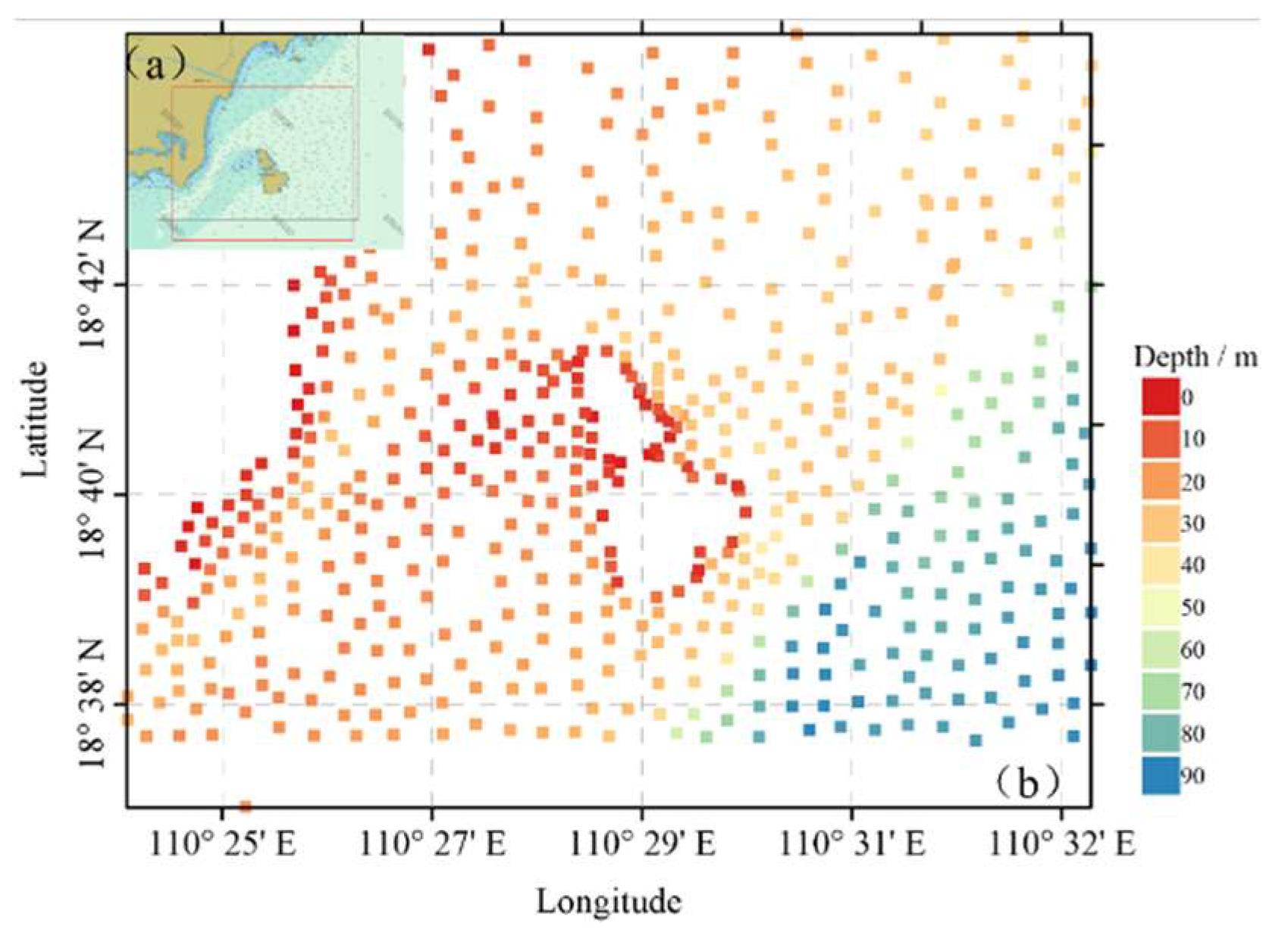
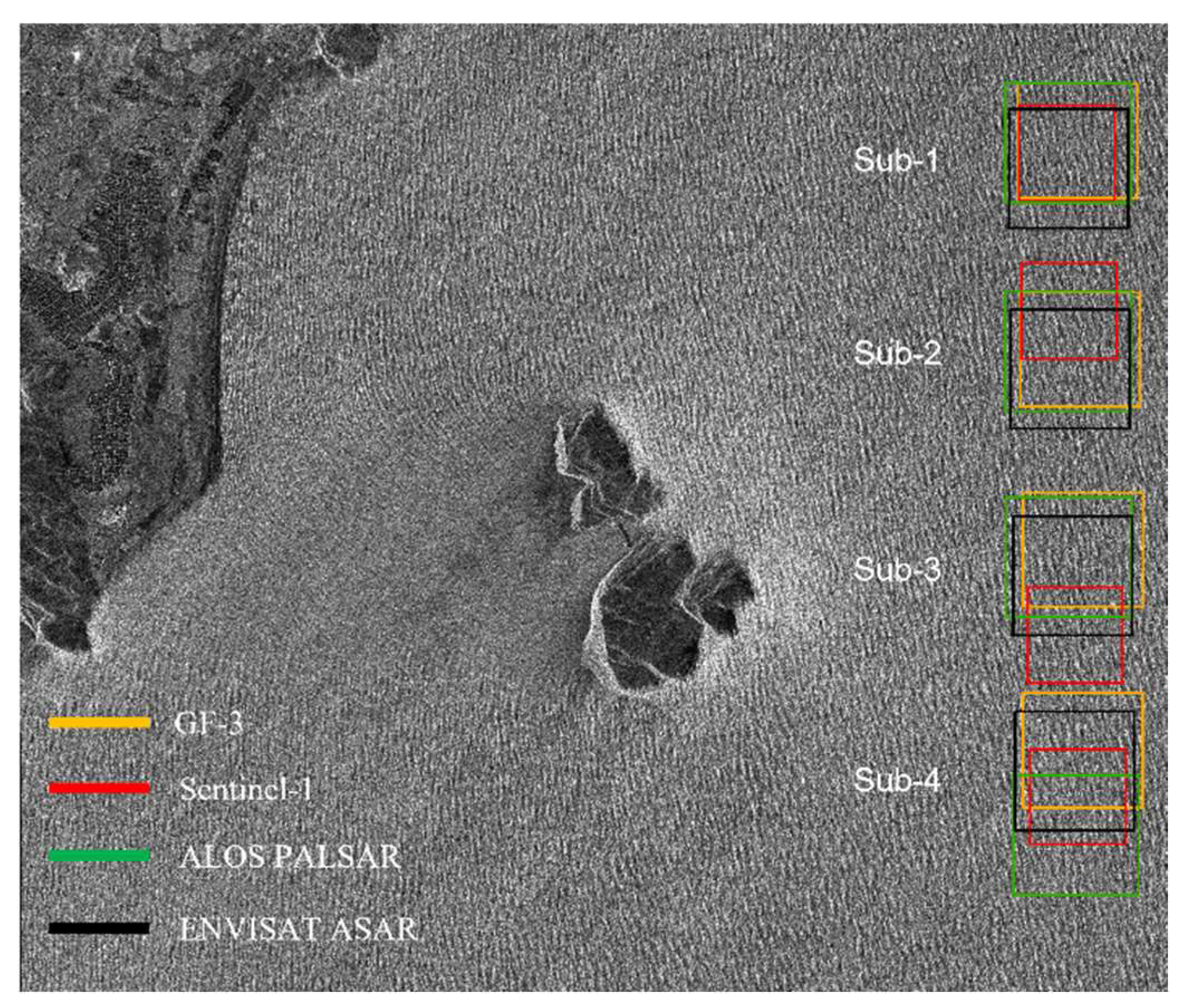
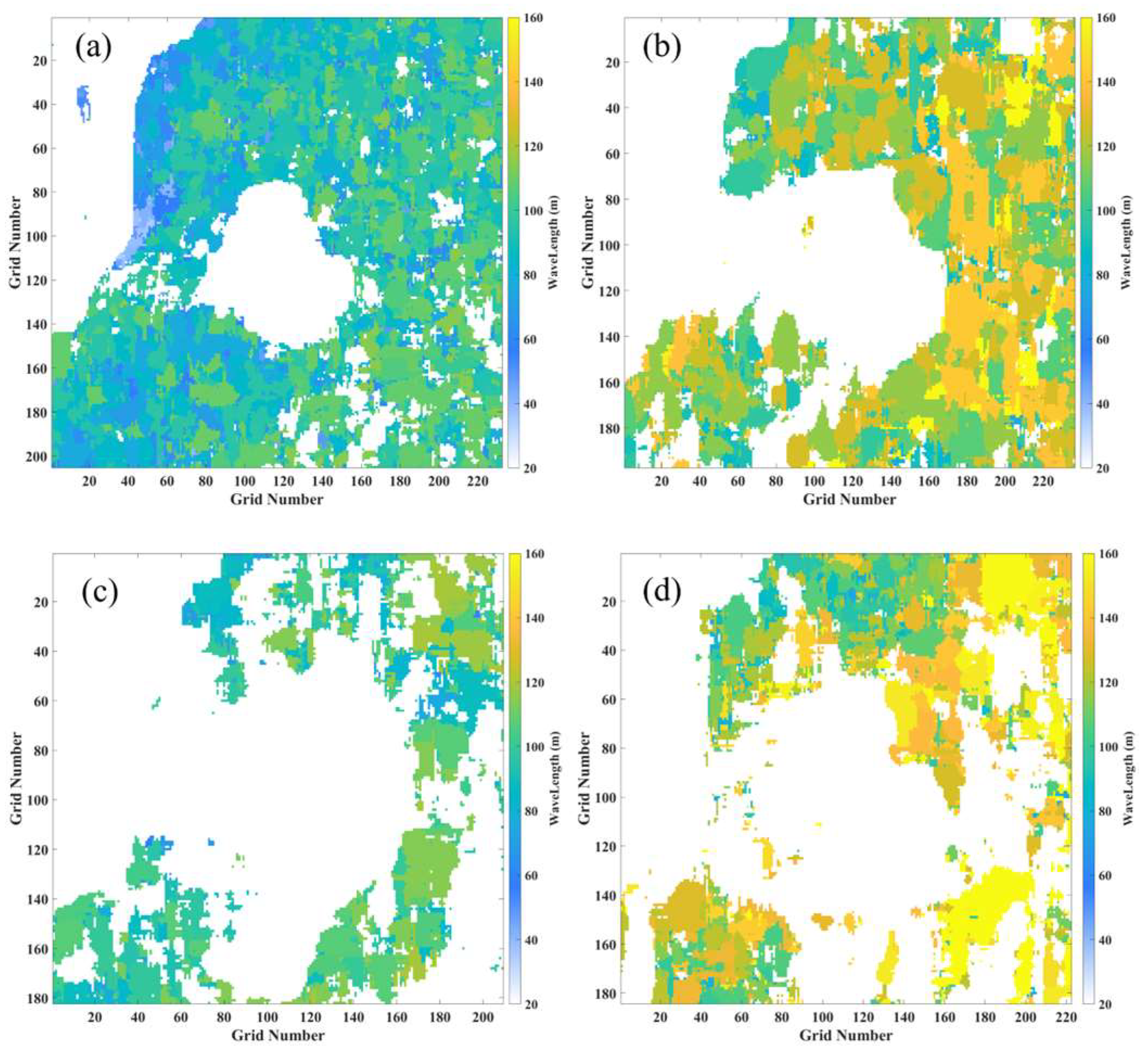
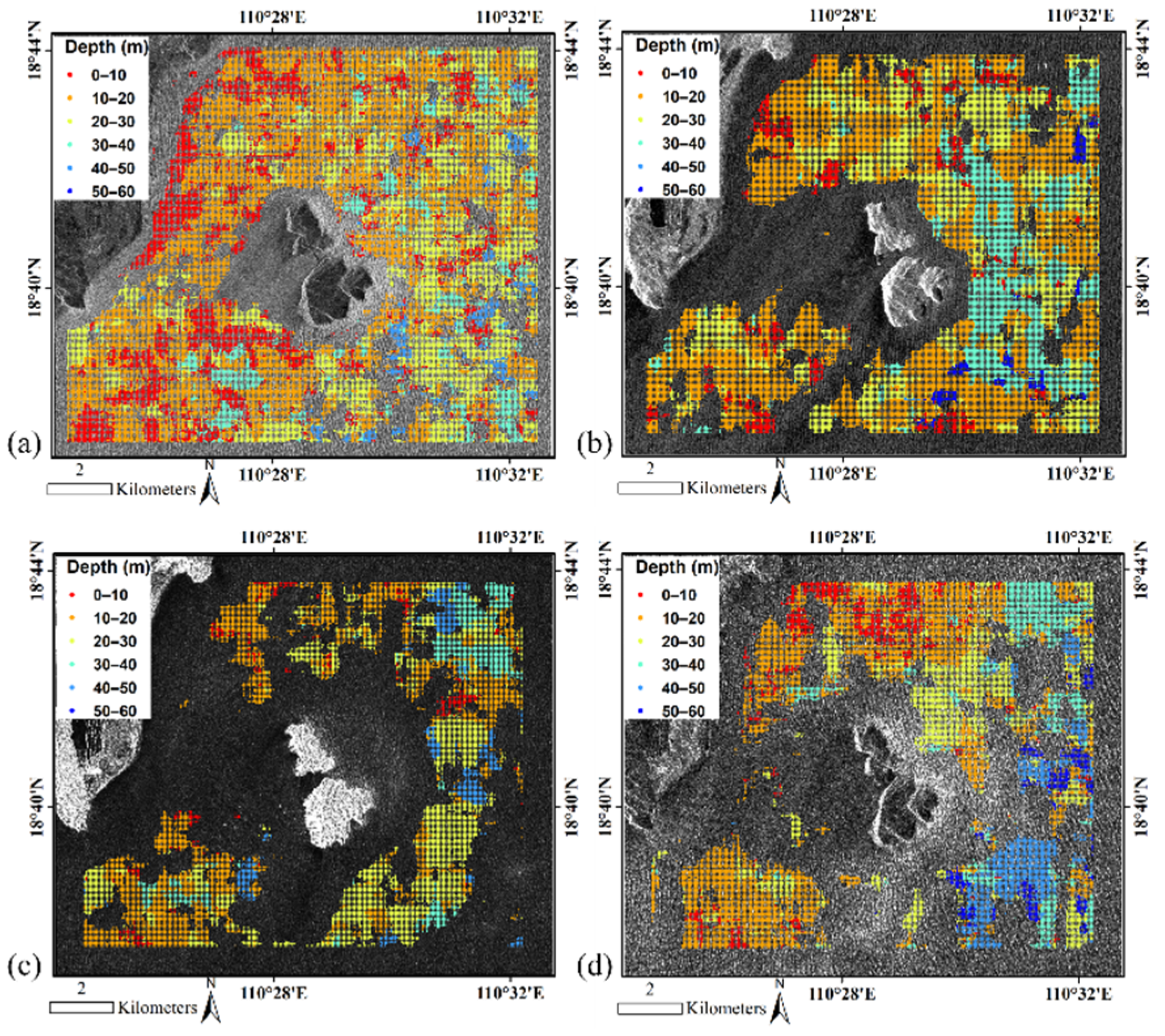
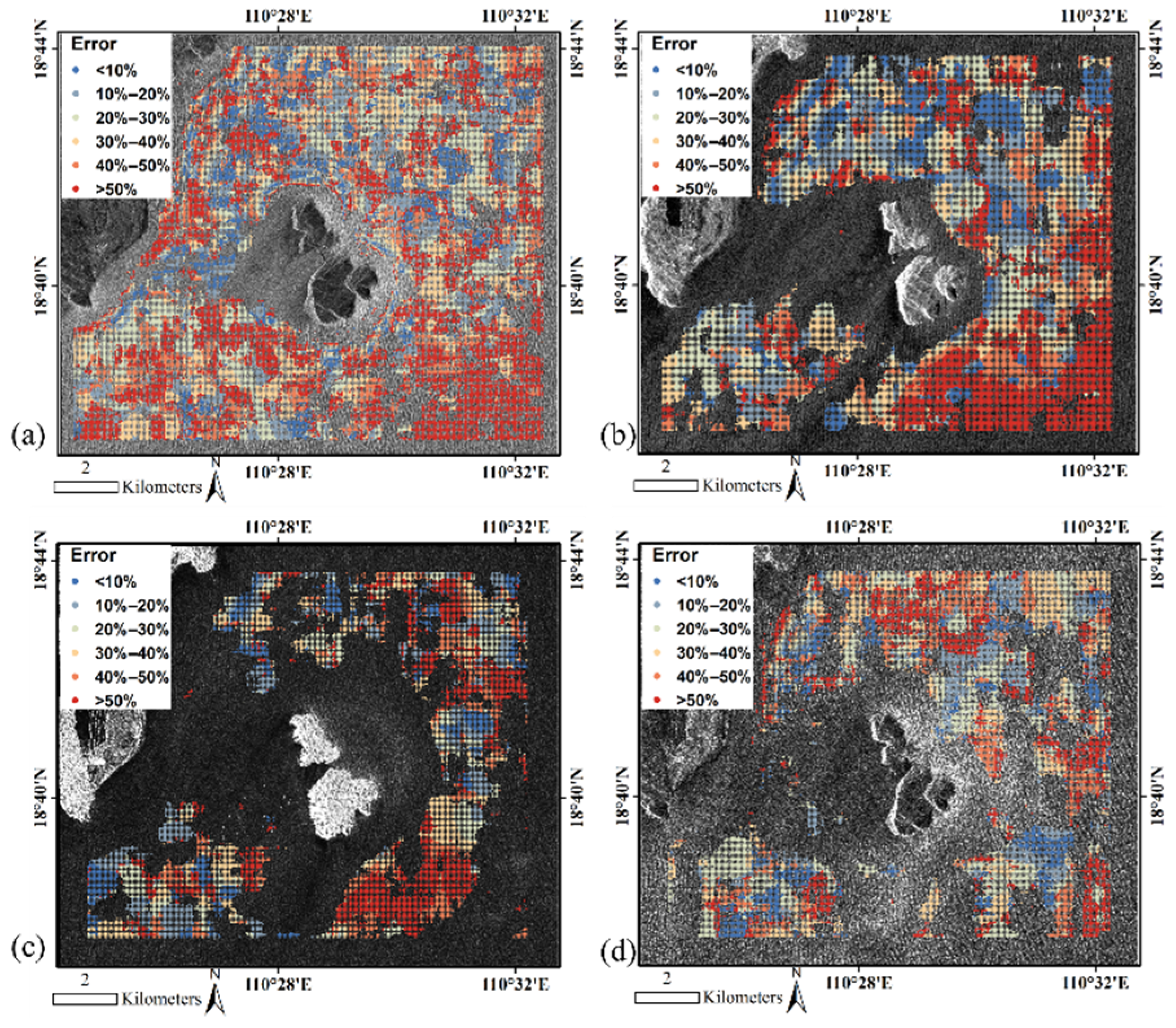



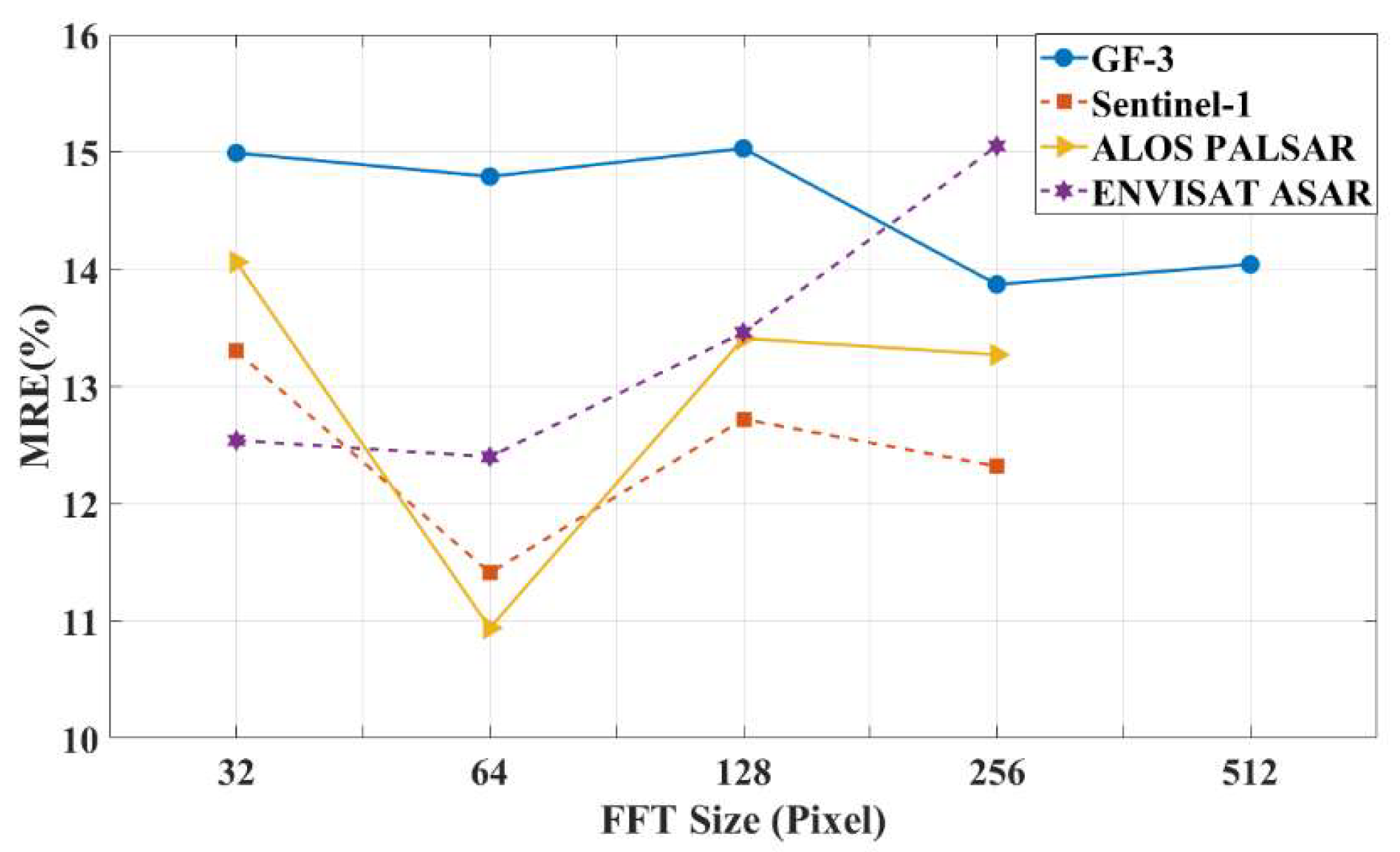
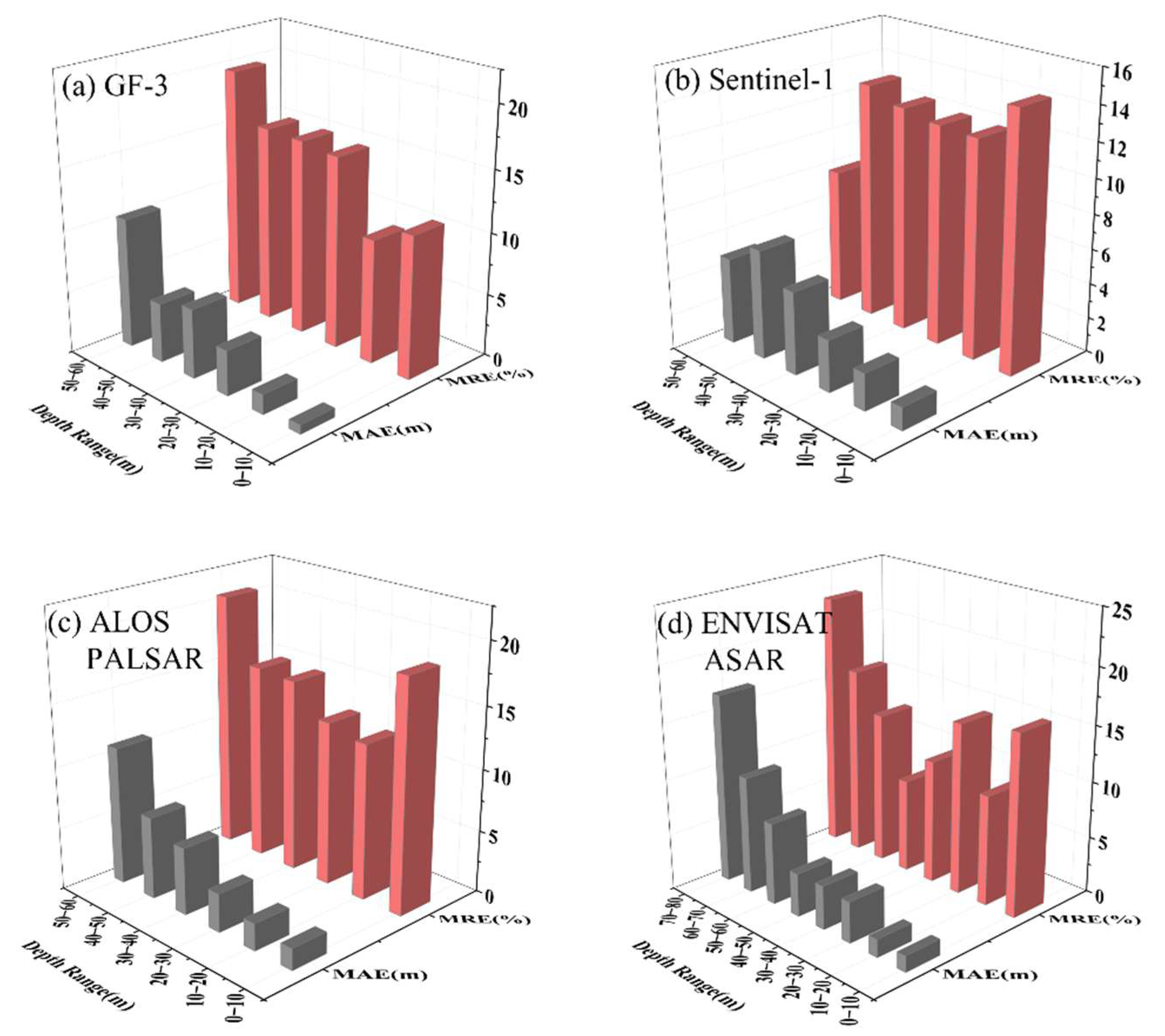
| Satellite | GF-3 | Sentinel-1 | ALOS PALSAR | ENVISAT ASAR |
|---|---|---|---|---|
| Imaging Time | 18 October 2019 | 24 November 2018 | 22 September 2007 | 13 March 2012 |
| Band | C | C | L | C |
| Imaging Mode | UFS | IW | FBD | AP |
| Polarization | HH | VV | HH | HH |
| Pixel Resolution (m) | 3 | 10 | 12.5 | 12.5 |
| Image | Sub-Region | Wavelength (m) | Wave Direction (degree) | Reference Water Depth (m) | Wave Period (s) |
|---|---|---|---|---|---|
| GF-3 | 1 | 111.24 | −8.97 | 30.35 | 8.72 |
| 2 | 113.77 | −17.35 | 34.20 | 8.74 | |
| 3 | 105.49 | −15.95 | 41.36 | 8.28 | |
| 4 | 122.30 | −9.46 | 68.41 | 8.86 | |
| Sentinel-1 | 1 | 141.35 | −6.34 | 28.59 | 10.3 |
| 2 | 158.76 | 7.13 | 30.96 | 11 | |
| 3 | 141.35 | 6.34 | 45.59 | 9.69 | |
| 4 | 141.35 | 6.34 | 73.39 | 9.53 | |
| ALOS PALSAR | 1 | 117.63 | −17.1 | 28.88 | 9.09 |
| 2 | 88.75 | −19.44 | 31.07 | 7.64 | |
| 3 | 136.70 | −19.98 | 39.73 | 9.61 | |
| 4 | 1600 | −90 | 75.32 | - | |
| ENVISAT ASAR | 1 | 155.41 | −29.05 | 28.68 | 11.02 |
| 2 | 155.41 | −29.05 | 31.09 | 10.83 | |
| 3 | 126.49 | −18.43 | 41.32 | 9.16 | |
| 4 | 187.27 | −20.56 | 68.93 | 11.07 |
| Image | MAE (m) | MRE | Number |
|---|---|---|---|
| GF-3 | 12.27 | 39.54% | 32,788 |
| Sentinel-1 | 13.19 | 36.27% | 26,422 |
| ALOS PALSAR | 11.62 | 36.11% | 11,471 |
| ENVISAT ASAR | 9.92 | 33.33% | 16,466 |
| Image | MAE (m) | MRE | Number |
|---|---|---|---|
| GF-3 | 3.30 | 13.78% | 10,168 |
| Sentinel-1 | 2.92 | 11.41% | 8738 |
| ALOS PALSAR | 2.40 | 10.94% | 3837 |
| ENVISAT ASAR | 3.37 | 12.40% | 7549 |
Publisher’s Note: MDPI stays neutral with regard to jurisdictional claims in published maps and institutional affiliations. |
© 2022 by the authors. Licensee MDPI, Basel, Switzerland. This article is an open access article distributed under the terms and conditions of the Creative Commons Attribution (CC BY) license (https://creativecommons.org/licenses/by/4.0/).
Share and Cite
Huang, L.; Meng, J.; Fan, C.; Zhang, J.; Yang, J. Shallow Sea Topography Detection from Multi-Source SAR Satellites: A Case Study of Dazhou Island in China. Remote Sens. 2022, 14, 5184. https://doi.org/10.3390/rs14205184
Huang L, Meng J, Fan C, Zhang J, Yang J. Shallow Sea Topography Detection from Multi-Source SAR Satellites: A Case Study of Dazhou Island in China. Remote Sensing. 2022; 14(20):5184. https://doi.org/10.3390/rs14205184
Chicago/Turabian StyleHuang, Longyu, Junmin Meng, Chenqing Fan, Jie Zhang, and Jingsong Yang. 2022. "Shallow Sea Topography Detection from Multi-Source SAR Satellites: A Case Study of Dazhou Island in China" Remote Sensing 14, no. 20: 5184. https://doi.org/10.3390/rs14205184
APA StyleHuang, L., Meng, J., Fan, C., Zhang, J., & Yang, J. (2022). Shallow Sea Topography Detection from Multi-Source SAR Satellites: A Case Study of Dazhou Island in China. Remote Sensing, 14(20), 5184. https://doi.org/10.3390/rs14205184




